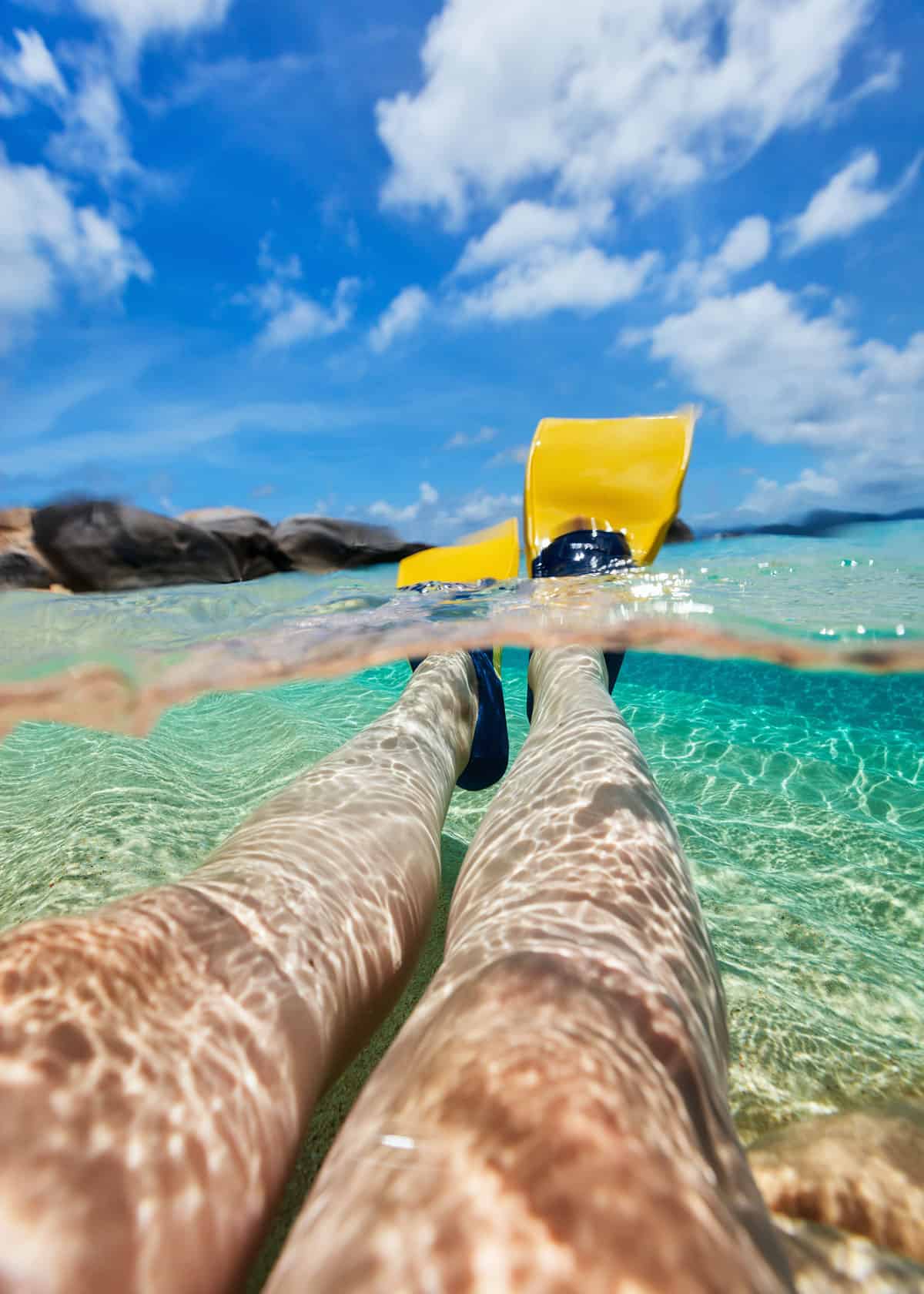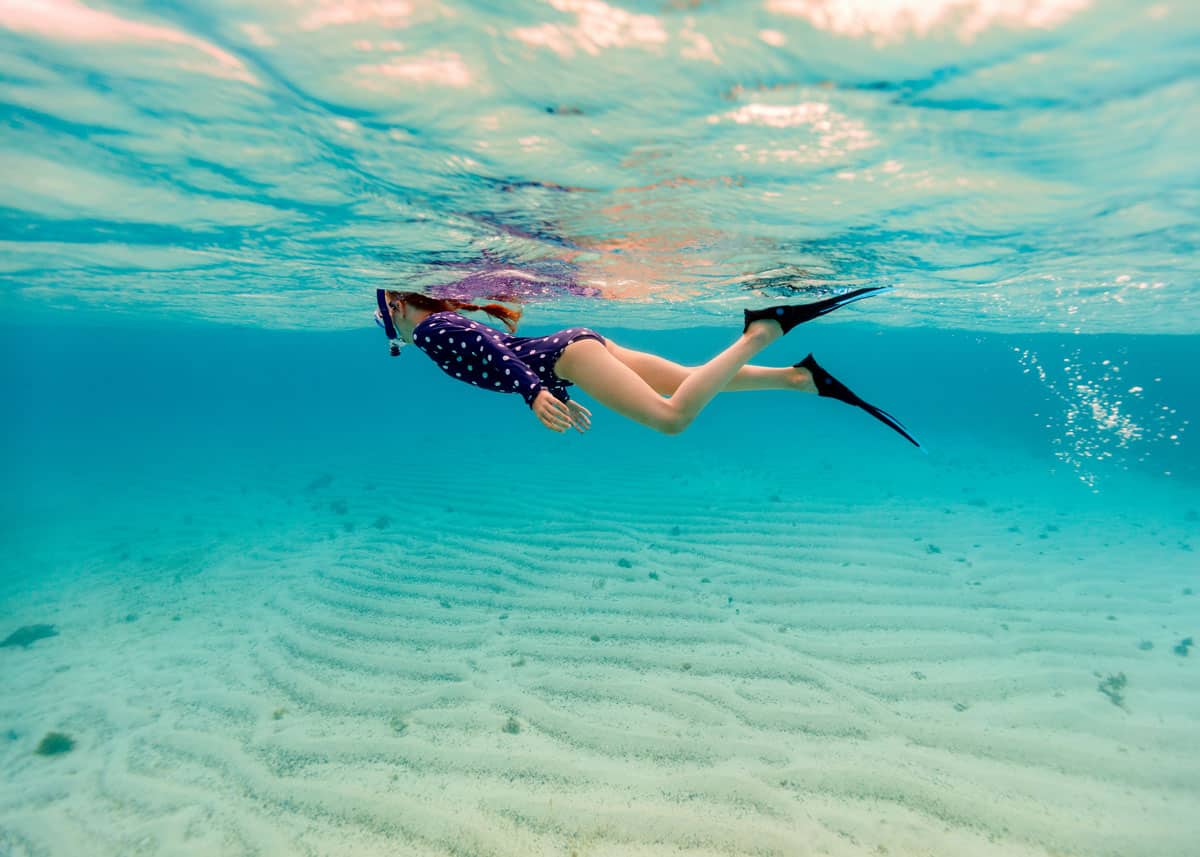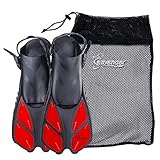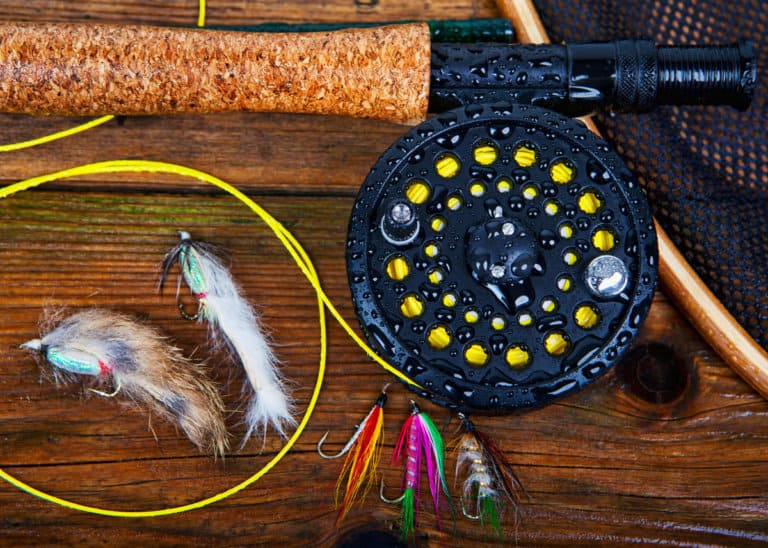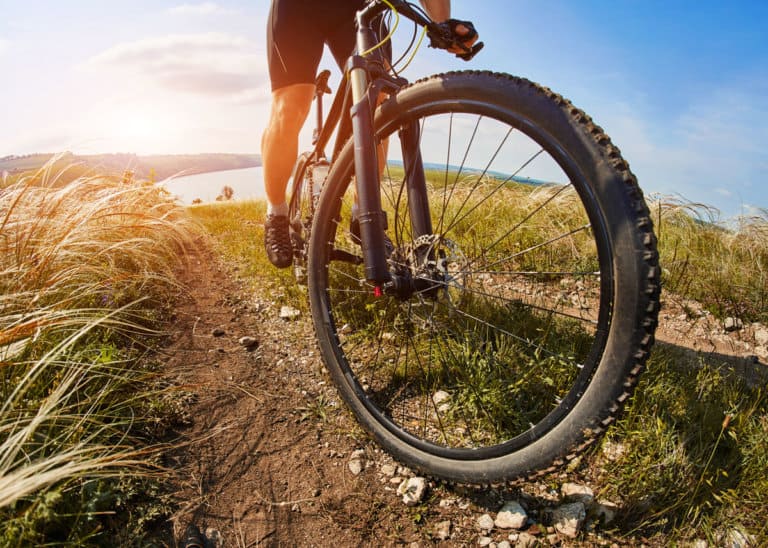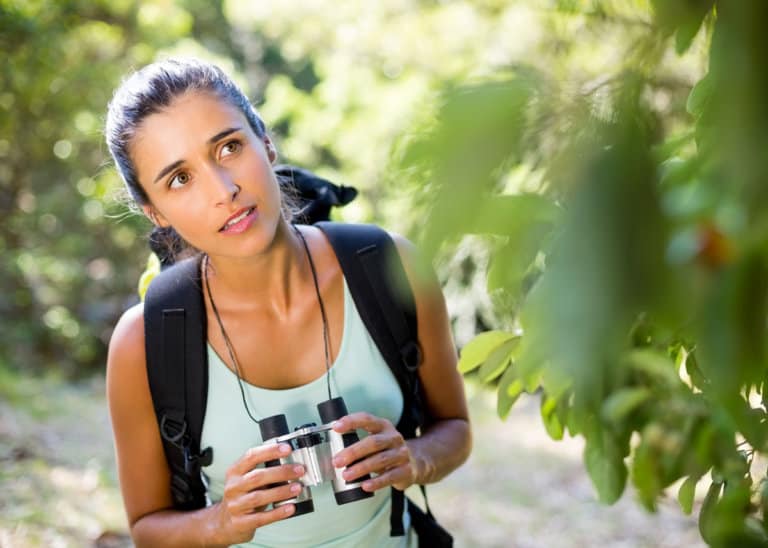10 Best Snorkeling Fins for Travel: Get the Right Fin and Fit
Want to swim further, with less effort? Sounds like you need a pair of snorkel fins. In this post, you’ll learn how to choose the best snorkeling fins.
Our guide will sort out the 3 types of fins (split, short, and paddle) and 2 types of fit (open heel and full foot). We cover adult and kid’s fins, especially for travelers.
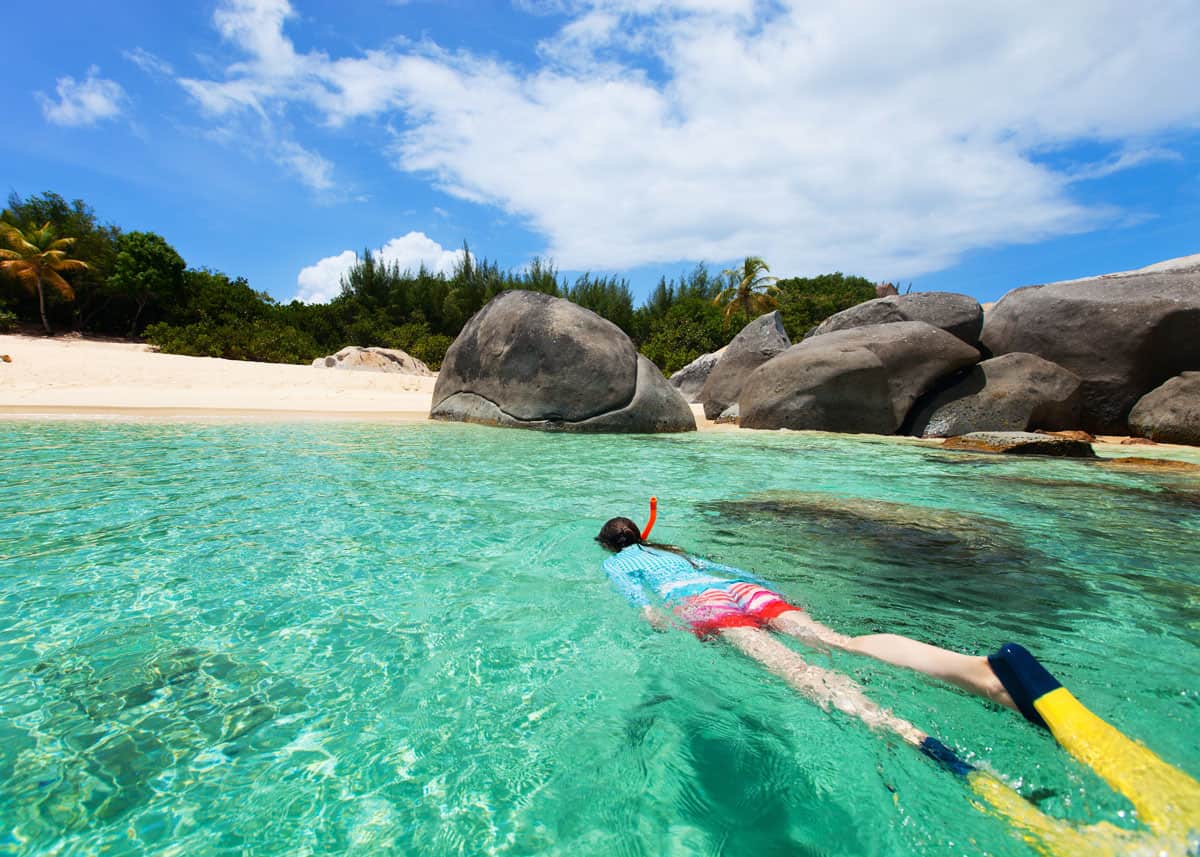
Want to capture your snorkeling adventure? Check out this GoPro Snorkeling Guide
Best Snorkeling Fins for Travelers
When we travel, we love to snorkel the local coves and reefs. And snorkeling is one of those family-friendly activities that make a trip worthwhile.
With that in mind, we’ve put together this buyer’s guide to help you find the right fins and fit for you.

Overall, this is a comprehensive guide about all things ‘snorkel’ so if you just want to know some great fins to buy here’s our top pick…
Our Top Picks: Best Value

U.S. Divers Pro FX Fins are our choice for best-value snorkeling fins. The gel straps are comfortable and adjustable.
The full blade of the fin is made of composite material for better snap and thrust. And because they are slightly longer you get further with each kick, making for a leisurely pace … not a ‘kick like crazy’ swim where you feel like you aren’t getting anywhere.
Check the current price for these fins.
They pack up neatly within their own mesh carry bag and are still small enough to fit into most carry-on luggage to travel.
Our Top Picks: Premium Snorkel Fins
Wildhorn Outfitters Topside Snorkel Fin is our choice for the best premium snorkel fins. They fit like a water shoe, making it easier to walk and snorkel in. They even have shoe treads!
Check the current price for these fins.
Big enough to provide a noticeable strength to your swim, they’re also compact enough to take on holiday. And the full-foot fit means you don’t need extra fin boots.
Our Top Picks: Kids Snorkel Fins
Cressi Rocks Kids Fins put the fun in snorkeling in a variety of colors.
They’re designed for years of use and have adjustable straps, so as the kids grow all you have to do it let the straps out.
Check the current price for these fins.
Designed especially for kids they even have a large thumb loop making it easy for the kids to get them on and off.
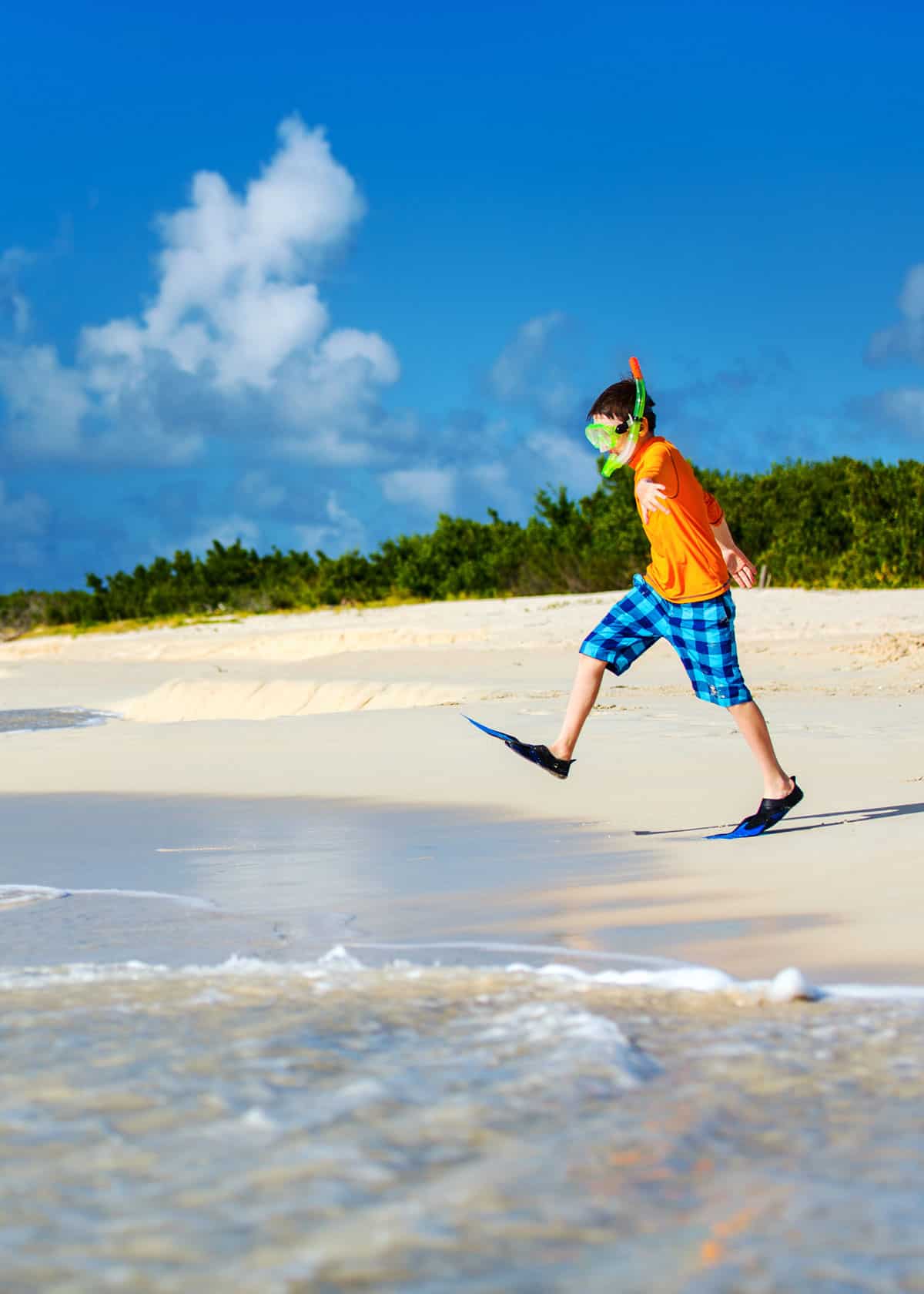
How to Get the Best Fit
Chafing and swollen/sore feet are not fun for anyone. Even less if you are in an amazing snorkel destination.
Here are some things to consider before you buy. If your fins are too tight this can be uncomfortable leading to blisters, missing skin from rubbing, cramps and even losing feeling in your toes.
Remember: Snug is okay, but tight is not right. Always make sure and check to buy the right size in plenty of time to return if it’s too tight in the full foot fins.
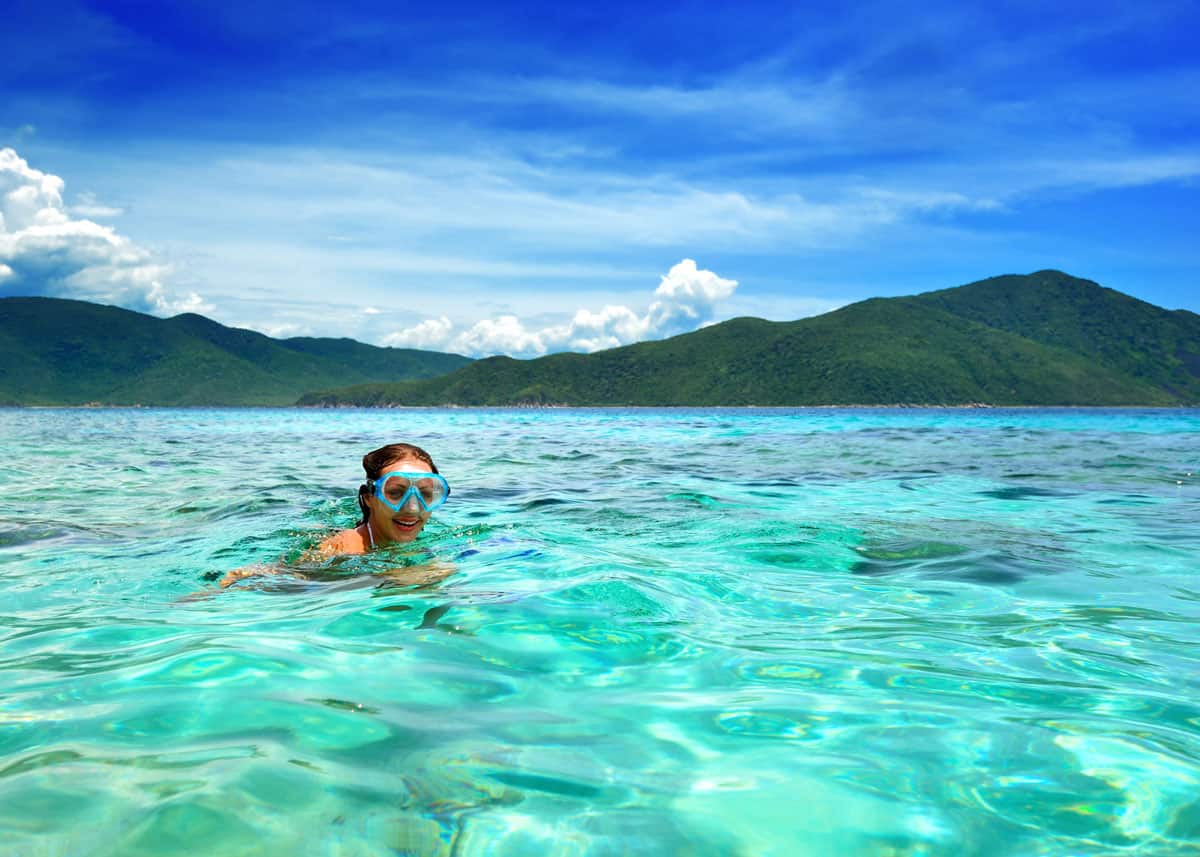
Full-foot vs. Open-heel Fin: Snorkel Fins Compared
There are two types of snorkel fins:
- Full-foot fin: These have a boot-like fit, with no adjustable strap.
- Open-heel fin: These are more common and can be easily adjusted for size. For comfort, many snorkelers like to add a snorkel boot (making it somewhat like the full-foot fin).
This comes down to personal preference. Both of these options are great, we’ll give you the pros and cons so you can decide which you prefer.
Full-foot fin: Pros and Cons
Pro: Comfortable, don’t have to adjust anything.
- Pro: Less gear to lug – no need to bring neoprene dive booties.
- Pro: Generally lighter and more travel-friendly.
- Con: If they are a little too tight you can end up with cramps, squashed toes, and an uncomfortable swim.
- Con: Because there are no booties, your foot has no protection walking in/out of the ocean. Not a big deal on sand beaches, but lava and coral landscapes can shred your feet pretty quickly.
Open-heel (adjustable) fin: Pros and Cons
Pro: Adjustable straps mean you can wear dive boots which is added protection for your feet and beneficial if you have to go over rocks, lava, or coral to get to the ocean. Plus, it means you can share with others, they just adjust to suit them.
- Pro: Dive boots also keep your feet warmer in cold water.
- Con: If not fitted correctly and are loose, they can slip off when you jump in or if kicking too hard.
- Con: Generally a little more expensive and heavier than full-foot fins.
Adjustable straps: Open-heel fins are versatile and able to be worn with or without booties. They are also quick and easy to adjust in the water by tightening the straps.
Split, Paddle (Solid) or Short Blades?
There are three types of blades. The names pretty well describe the differences.
- Split blade: These have a split up the middle, allowing each half to move somewhat independently.
- Paddle blade: These are the traditional style fins. The blade is one solid piece.
- Short blade: As the name suggests, this style blade is shorter than the standard blade. These are easier to walk in. They also provide less thrust than a longer blade.
With fins: length = propulsion.
With split fins the propulsion come from the speed of the kick whereas with paddle fins it is the strength of the divers kick. It depends on the type of swimmer you are and what you prefer.
Most snorkel fins are solid paddle fins that are short and compact, allowing you to maneuver easily on the surface. The huge long fins that are used by spearfishermen and free divers aren’t necessary when you are only swimming /snorkeling on the surface.
Now all you have to do is choose the fins you think are right for you. It’s all about personal preference and what they will be used for.
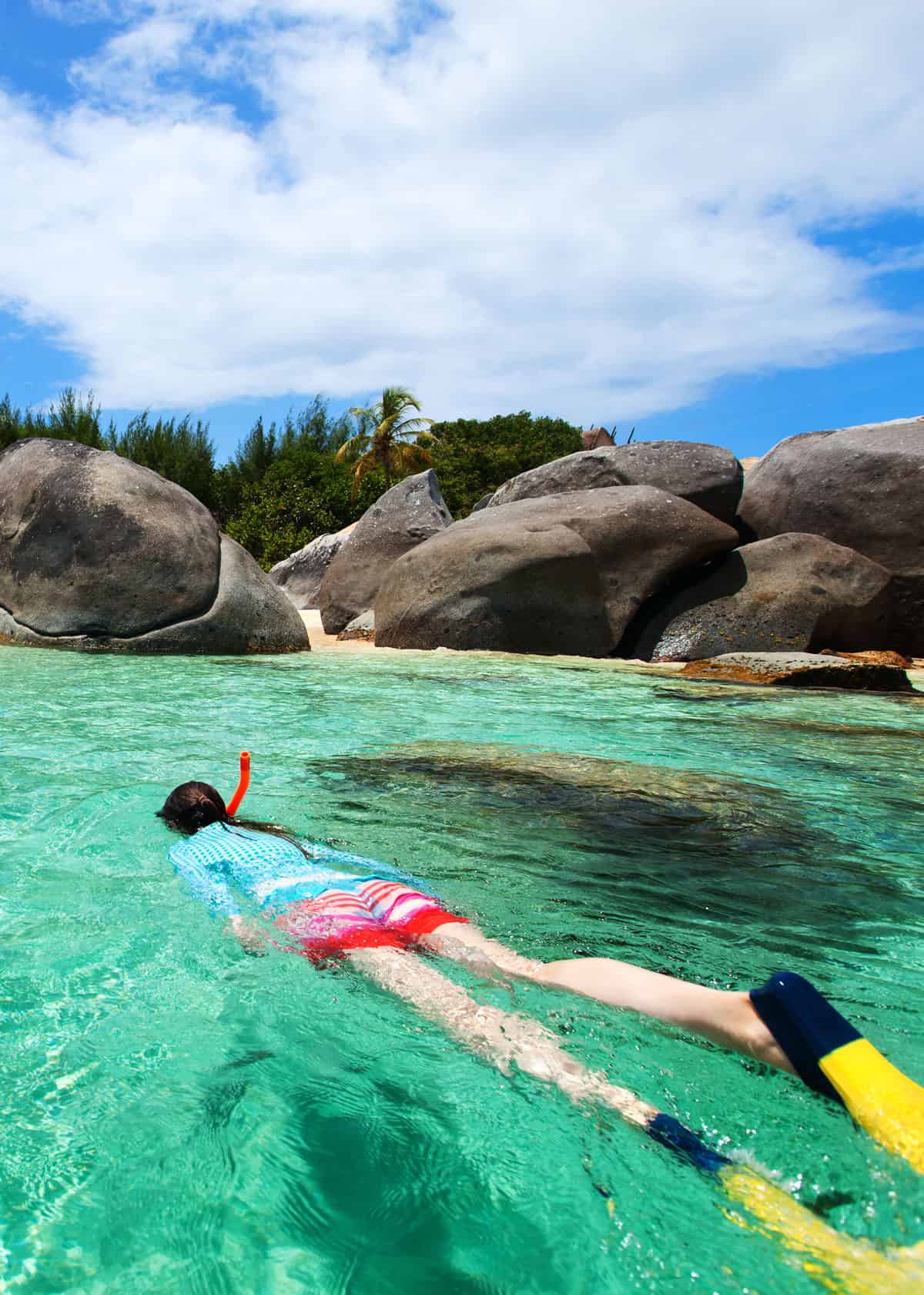
Choosing the Best Fins for You: 4 Considerations
Here are some things to consider when buying snorkel fins:
- Usage: How often they will be used? Maybe once a year on vacation, or every weekend at your local beach?
- Comfort: How far or long do you usually swim? Of course, you’ll want to be comfortable.
- Safety: Do you want to protect your feet by wearing booties to enter the water?
- Size: Will they fit in checked luggage for your next vacation?
10 Best Snorkel Fins for Beginners
With these considerations in mind, here are some great choices:
1. U.S. Divers Proflex FX Fins
Best Value Choice: U.S. Divers Proflex FX Fins are built for comfort no matter what size your foot is.
The gel adjustable straps are soft enough so as not to rub and because they are adjustable you can have the freedom of wearing little booties or socks with them for added comfort and protection entering or exiting the water. Plus, you can lend them to friends, all you have to do is adjust the straps.
Check the current price for these fins on Amazon or US Divers
The foot pocket is soft, cradling your foot while swimming for added comfort while the full blade of the fin is harder allowing for maximum propulsion through the water.
Because they are slightly longer you get further with each kick making for a leisurely swim not a ‘kick like crazy’ swim where you feel like you aren’t getting anywhere.
They pack up neatly within their own mesh carry bag and are still small enough to fit into most carry-on luggage to travel.
2. Wildhorn Outfitters Topside Snorkel Fin
Best Premium Choice: Wildhorn Outfitters Topside Snorkel Fin is a comfortable way to snorkel in a full boot fin. It fits like a shoe (because it actually is one) making it easier to walk around in, swim, snorkel or enjoy a variety of other water sports.
Check the current price for these fins.
Big enough to provide a noticeable strength to your swim, they’re also compact enough to take on holiday.
3. Anggo Short Dive Fins
Anggo Short Dive Fins have a soft foot pouch for maximum comfort, it’s as easy as slipping them on and you’re ready to go!
They come with pads to keep them in shape when you are not using them – so they’ll be just as comfortable the next time you use them.
Check the current price for these fins.
Also complete with their own quick-dry mesh bag makes drying, storing and space-saving easy. They’re small and lightweight too, easily fitting in your beach or travel bag.
Best Snorkel Fins For Kids (Open-heel)
4. Cressi Rocks Kids Fins
Best Kids Fins: Cressi Rocks Kids Fins put the fun in snorkeling in a variety of fun colors – blue and green, pink and white, or purple and pink.
They’re designed for years of use, made from premium materials, and have adjustable straps so as the kids grow all you have to do is let the straps out.
Check the current price for these fins on Amazon or Divers Supply
Easy to use and a great money saver not having to buy new fins for each year’s holiday. Designed especially for kids they even have a large thumb loop making it easy for the kids to get them on and off.
5. Capas Snorkel Fins
Capas snorkel fins soft foot pocket means they’re comfortable enough to go barefoot as you slip them on and off easily with the big thumb loops.
Their adjustable straps and size range mean they’ll last for years as the kids grow. Lightweight and small enough to pack in luggage, they’ll be enjoyed for years to come no matter where you go.
Check the current price for these fins.
Premium Snorkel Fins
Suitable for any aquatic activity these fins are built for comfort. You can go barefoot, with neoprene socks, or booties for diving.
The fin pocket surrounding your feet feels luxurious cradling your feet in a softer elastomer for maximum comfort on those long swims, hours of snorkeling or scuba diving.
6. Cressi Snorkeling Adjustable Fins
Cressi Snorkeling Adjustable Fins has extra-long blades allowing for maximum propulsion with a minimum of effort so you can enjoy your time in the ocean without getting tired fast.
Check the current price for these fins on Amazon or Scuba.com
These fins have a side rail running along the extra flexible blade which allows maximum power transmission. This makes swimming easy so you can conserve your energy.
And let’s not forget, the easily adjustable straps are perfect for anyone in the family to use, all you have to do is pull.
7. Cressi Full-foot Pocket Fins
Cressi also have a full foot pocket option available with all of the comfort and features as those above, only in a full foot. They are molded and built for maximum comfort and power.
Check the current price for these fins.
Specially designed for snorkeling or just a long swim, they will make your time in the water worth it.
Travel / Short Snorkel Fins
Looking for a compact pair of great fins? Here are a couple of options that will fit in your carry-on luggage.
8. Cressi Agua Short Travel Fins
Cressi AGUA SHORT are a smaller travel-sized version of their popular Agua fins.
Check the current price for these fins.
Made of quality materials the soft foot pocket is self-adjusting, molding to your foot for an amazing fit and comfort.
 9. Seavenger Torpedo Swim Fins
9. Seavenger Torpedo Swim Fins
Seavenger Torpedo Swim Fins are small enough to fit in carry-on making them perfect to take on vacation.
Check the current price for these fins.
Available in a range of fun colors, they are durable, compact, easy to slip on and off, and also comfortable enough to go barefoot.

10. Cressi Palau Short Fins
Cressi Palau Short Snorkeling Fins tick all the boxes of durability, comfort, longevity and ease of use.
Check the current price for these fins.
Suitable for ocean swimming, snorkeling or even in the pool doing laps, they can go everywhere and do everything.
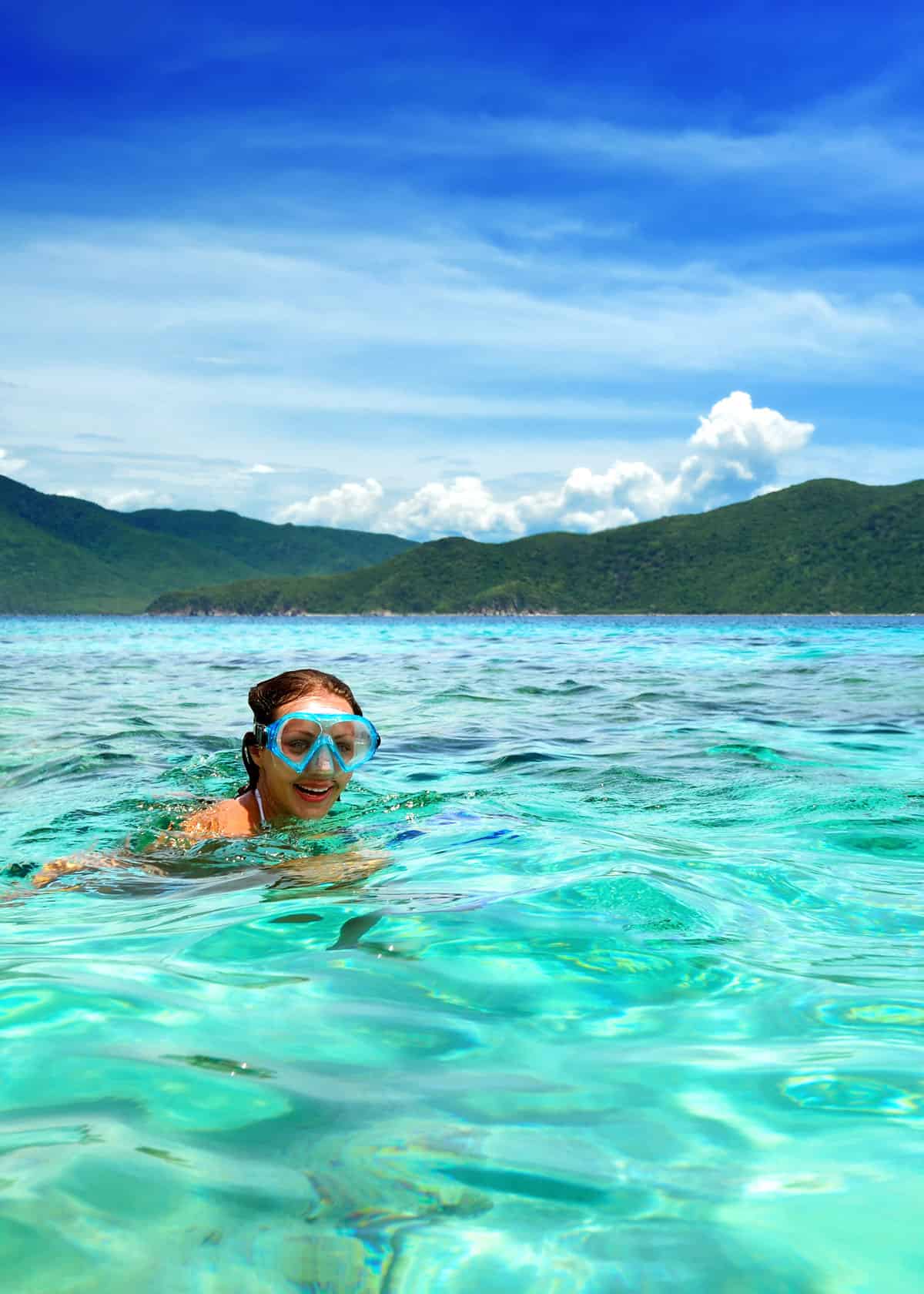
More reading: How to start a campfire (Ultimate Guide)
Snorkeling Tips and Safety
Here are a few tips for a successful snorkeling trip.
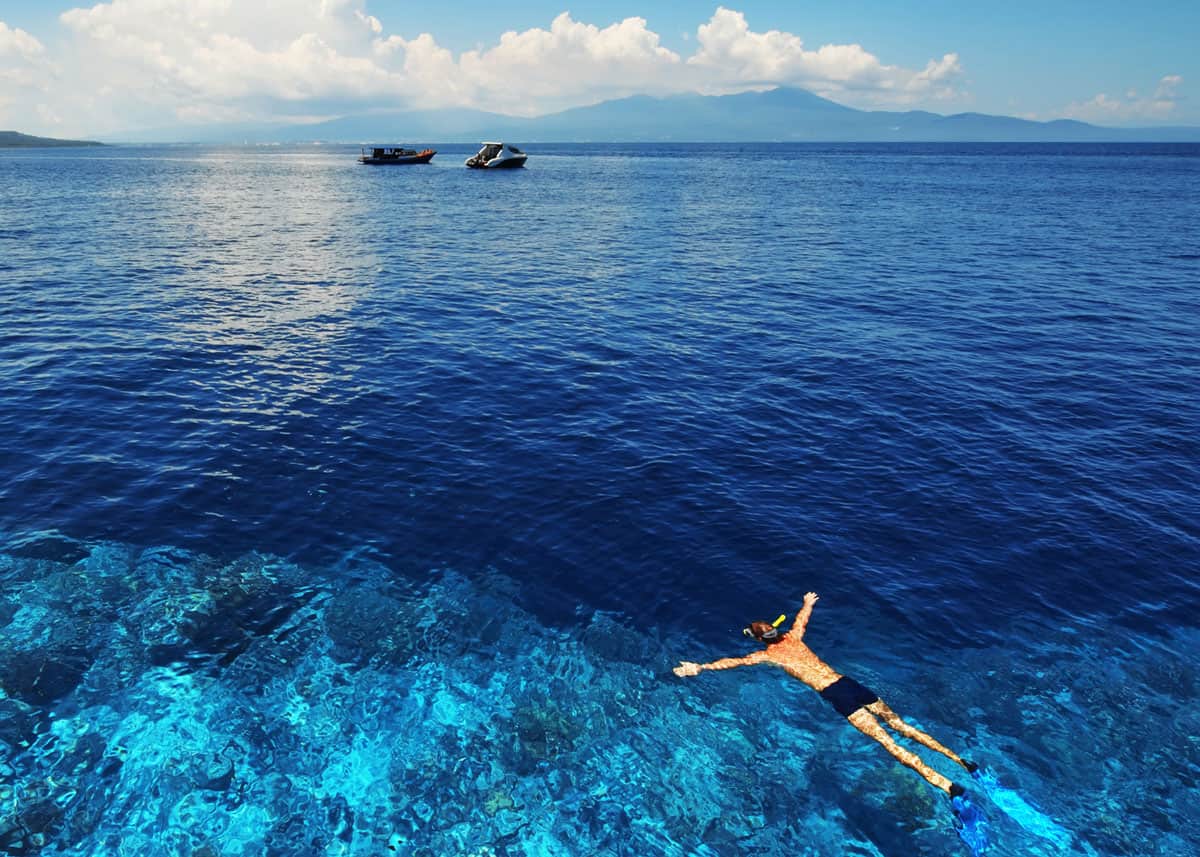
Your Turn
Where are you going snorkeling? What is your favorite type of fin? What do you hope to see on your next snorkel? Join me in the comments!
